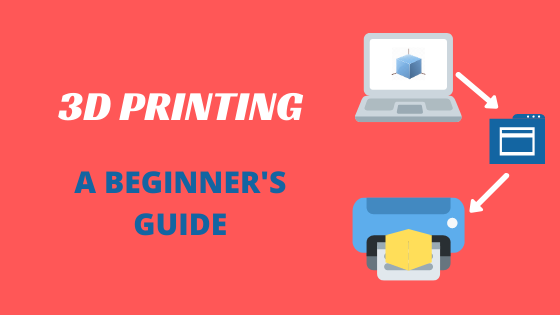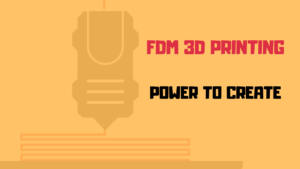In this article you will be able to understand about 3D Printing, as we always do, we will try to cover all aspects of 3D printing. At the same time, we try to keep things simple.
Table of Contents
What is 3D Printing?
3D stands for three Dimensional.3D printing is a process of converting a digital copy of an object to actual three-dimensional objects using additive technology.
Conventional manufacturing has always been based on material removal technology.3D printing is disruptive in that sense. It is layer by layer addition of material to produce a final desirable product.
In short,3D printing is additive manufacturing and it is the process of converting digital copy to actual physical product.
What is the working Principle of 3D Printing?
3D printing is also called additive manufacturing. Additive in additive manufacturing refers to layer by layer addition of material to produce the desired product. Its is thin layers of material stacked over each other. The thickness of the layer varies from 16 to 180 microns.
3D Printer is very much like a conventional inkjet printer, operated using a computer.3D printer deposits molten material layer by layer(attached using additive or ultraviolet rays) as per the 3D model of the product.
The process can be further exemplified using an example of the wall building process. As in wall building process layers of bricks are used for building the desired structure, in 3D printing layers of molten plastic or powder are used for building the desired structure.
What are the steps in 3D Printing?
Step 1-3D model Making :
As in conventional printing, we need a digital copy for printing(in the form of pdf, doc, etc), we need a digital copy of design in 3D printing.
A digital copy of the design for 3D printing is made using CAD software or 3D scanning. Generally used format for 3D printing is STL format.STL derived its name from Stereolithography.STL is not a tailor-made format for additive manufacturing, so it can cause certain issues. To resolve this issue Additive Manufacturing File Format (AMF) was introduced in 2011.
Step 2-Slicing :
Slicing is the process of converting the 3D model in a stack of flat layers. Slicing is done using slicing software. After this slicing software describes these layers as linear movements of the 3D printer extruder, fixation laser or equivalent.
Step 3-Material Selection :
The Next Step is to choose a suitable material for 3D printing. It depends on our application. In a 3D printer, we use filaments made of different materials. Filaments serve as the “ink” for 3D printers. A varied range of materials can be used for 3D printing. Such as plastics, ceramics, resins, metals, sand, textiles, biomaterials, glass, food and even lunar dust.
Step 4- Printing :
Once the model is loaded in the computer it gives instructions to the 3D printer for depositing material layer by layer. A 3D printer essentially works by extruding molten plastic through a tiny nozzle. It moves around precisely under computer command. The printer prints one layer waits for it to dry, and then prints the next layer on top. This process continues until we achieve the desired product.

What Materials are used in 3D Printing?
Various materials such as plastics, ceramics, resins, metals, sand, textiles, biomaterials, glass, etc are being used for 3D printing nowadays.
Material selection depends on the application, aesthetics and Certification requirements of the 3D printed objects.
The application includes factors like durability, product life cycle, etc. For example, if we need a product to last long, in that case, the wax won’t be a good material to use.
Aesthetics are an important part of the product experience. Hence depending upon application material selection can be done. For example, if we are making a product that is not visible due to covers, excellent aesthetics would be the least emphasized aspect of the product.
There are multiple global certifications, which the product has to comply with to be used. So the selection of material should consider this aspect.
Which 3D Printing technique to be used?
Different types of 3D printing materials require a different type of 3D printing techniques.
If the material used is Plastic or aluminide, Fused Deposition Modeling (FDM) Technology or SLS technology shall be used.
In case the material used is Resin or Wax, Stereolithography(SLA), Digital Light Processing(DLP), Continuous Liquid interface production(CLIP) or Multijet printing shall be used.
If we are using metals as input material Digital Light Processing(DLP), Direct metal laser sintering(DMLS) or Electron beam melting techniques shall be used.
What resources are required for 3D Printing?
CAD(Computer-Aided Design) Software or 3D scanning equipment
The 3D design file has to be created for the desired object using CAD software.CAD software is similar to other professional software like Photoshop, Illustrator, etc.
Operating CAD software requires a certain level of expertise. Although all being said, CAD software is not very difficult to master.
An alternative to CAD software is the use of 3D scanning.3D scanning is the process of analyzing a real-world object or environment to collect data on its shape and possibly its appearance (e.g. color). The collected data can then be used to construct digital 3D models.
Slicing Software
Slicing software is used in all 3D printing processes to convert CAD models in form 3D printers can understand. As the name suggests slicing software breaks down CAD model in stacks of horizontal layers.
Also slicing software describes layers in linear movements of 3D printer extruder, fixation laser or equivalent. These movements along with other specifications are converted into G-Code files, which indeed could be understood by a 3D printer.
3D printer
The third element required for 3D printing is the 3D printer itself. The 3D printer has a bed, Extruder nozzle, material wire.
The bed is a platform on which layer by layer deposition of material is done.
The nozzle is which ejects molten material for layer deposition. The material before it is extruded through the nozzle is in the form of a wire.
Vertical movement in the 3D printer is done by the bed in increments of layer thickness.
Applications of 3D Printing?
3D printer was first invented in the 1980s by Chuck Hull. Initially, it was used for prototyping only. That is why it was called rapid prototyping. It eased the tedious work of making a prototype. Before the advent of 3D printing, prototypes were made manually, it uses to take weeks and was very expensive and accuracy was also compromised.
But now since its inception 3D printing has gained application in varied industries.
Aerospace
Due to 3D printing’s ability to make complex shapes,3D printed parts have gained acceptance in the aerospace industry.
Automotive
Smaller lead times and scope for customization have made it easy for the automotive industry to use it for making jigs and fixtures. Also, 3D printing’s ability to make complex shapes is making it easier to produce automotive parts.
Healthcare and Prosthetics field
This is the segment 3D printing that has benefited the most. Currently, in the US most of the hearing aids are made using 3D printing. It has substantially reduced cost and production time for this segment.
What are the benefits of 3D Printing?
3D printing has been replacing subtractive manufacturing in many industries.3D printing has distinct benefits over conventional manufacturing. Benefits 3D printing offers are as follows :
Reduced product development time
3D printing has reduced the development lead time of new products in a significant way. Conventional proto-typing methods take days or even weeks to test a single prototype, whereas 3D printing can get the same done in hours,
Since the time taken to make prototypes are reduced, multiple iterations can be done to find a better product-market fit.
Reduced Waste
In conventional manufacturing(subtractive manufacturing) product is produced by material removal from a solid block to produce the desired object. This leads to a lot of waste. But 3D printing is an additive kind of manufacturing, so the wastage of material is almost nil.

Handling complex shapes
3D printing can make complex shapes very easily. It can make very complex, detailed and precise components very easily. Conventional manufacturing(subtractive and injection molding) faces challenges in handling complex shapes as they are restricted by geometric limitations of molds and tools.
Customization
Customization is the coolest part about 3D printing. You can customize your product by changing its 3D model.
Imagine you can make customized gifts for your loved one, in the comfort of your home.
Cost-Effectiveness
In any manufacturing process, overhead costs play a huge role and contribute significantly to the product cost. 3D printing requires minimal labor, hence labor costs are almost eliminated.
In conventional manufacturing, you need multiple experienced machine operators and technicians to handle production. You need huge space and multiple pieces of machinery to handle conventional or traditional manufacturing.3D printing doesn’t require much of it. A single operator can produce a complete part just with a press of a button.
Better Quality and Strength
Fine quality products can be made in 3D printing by varying layer thickness.
Also since complex shapes can be made as an integrated component in 3D printing, it provides better strength. In conventional manufacturing because of geometric constraints creating a single integrated unit is a very tough job.
Less Dependence on Skill
To find skilled manpower and to retain it, is the biggest problem the industry is facing nowadays.3D printing brings a shift from skill-based manufacturing to machined controlled manufacturing.
What is the Future of 3D Printing?
3D Printing stands to disrupt many industries in a big way. It has already disrupted the biomedical field.
The biggest change it would bring is the democratization of manufacturing. In the future, 3D printing machines could make their way into homes, businesses, disaster sites, and even outer space.
3D printing would not only improve operational productivity but also create a social impact. Homebuilding using 3D printing will make it easily accessible and affordable. Possibilities to build 3D printed human organs to building hearing aids are remarkable achievements in the medical field.
3D Printing is going to revolutionize production in the coming times, but it doesn’t mean it would completely replace traditional manufacturing. High volume productions of similar parts would still need injection molding.
3D printing has a wide and varied array of applications. Many different industries are starting to introduce 3D printing into their processes in an attempt to benefit from using technology in different ways. 3D printing as a technology is growing very fast. Considering all the advantages 3D printing offers, it is obvious that this will soon become a technology that will overtake traditional methods, it is just a matter of time.
References :




